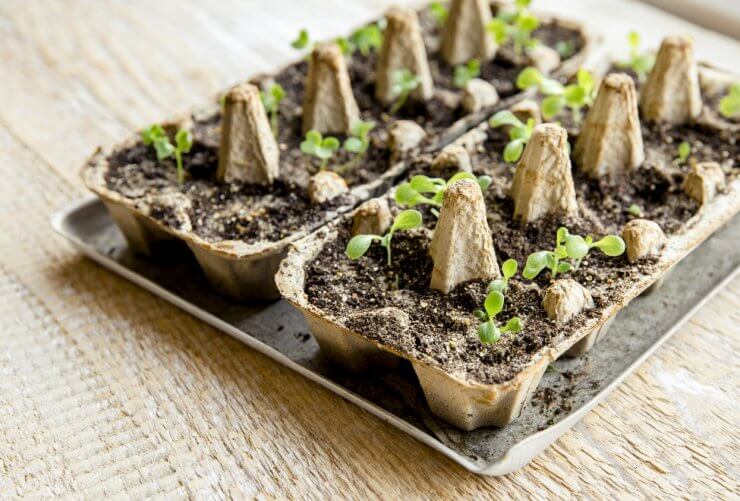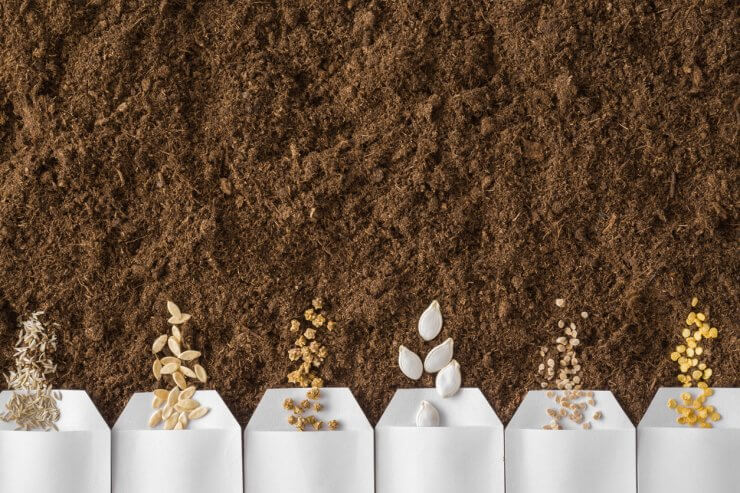
One of my favorite moments in the depths of winter is when I can start my seeds. That’s the instant in time when the countdown begins. I know that soon I’ll be able to get my hands into the soil and the season of fresh, delicious vegetables is just around the corner. That is, unless, these common seed starting problems crop up. Then I need to give up and throw my hands in the air.
I’m joking, of course. Yes, almost every gardener can expect to deal with these common seed starting problems at some point. Fortunately, because they are so common, there are bushels of solutions available to us. No need to give up. No, you’re not a hopeless gardener. And yes, you can still subscribe to your favorite farmer’s CSA. We’re still going to get those seeds going!
Discover 7 top tips for growing, harvesting, and enjoying tomatoes from your home garden—when you access the FREE guide The Best Way to Grow Tomatoes, right now!

Don’t give up! These common seed starting problems are easy to overcome.
There are a lot of reasons your seeds might not germinate or may fail to thrive once they do. Here are some of the most common seed-starting problems you’ll encounter and some ideas on what you can do about it.
One of the overarching issues with seeds is that they won’t germinate. Though not a solution, you can always germinate seeds before you plant them. That will at least save you some frustration of wondering if your seeds are viable or not. Check out How to Germinate Seeds More Quickly for some pointers. As for more specific germination problems and solutions, this deserves several sub-points because there are about 40 million reasons your seeds may not germinate. (Okay, maybe not that many, but there are a lot.)
1. Seeds are too old. Look, I get that you’re wondering about those seeds you found in the attic seven years after you moved into your current home. I’d be curious, too. But seeds only have a limited shelf life. Around five years is the top end of viability for most vegetable seeds, and it’s much less than that for many seeds. Never mind that the attic is no place to store seeds, which we’ll touch on next.
2. Improper storage. Seeds need to be stored in a cool, dry, dark place. A ziplock bag in your refrigerator or freezer works, as does an envelope in a shoebox in your pantry. The attic, though? Or your garage? For most of us, there’s too much temperature fluctuation and humidity in our attics, garages, or other semi-outdoor spaces.
3. It’s too hot or cold. I can’t blame seeds for failing to germinate when it’s too cold. I don’t want to get out of bed on a frigid morning, put my feet on an icy floor and take the dog out into a frosty, barren wasteland. Why would seeds be any different? If you’re trying to start your seeds indoors, find a warm spot or invest in a heated mat. If you’re starting seeds (like beets or radishes) outdoors, you may just need to wait until the temperature is right. On some occasions, you may also find that it’s too hot to start certain seeds.
4. It’s too dark or too light. If you bury your seeds too deep, the sprouts won’t reach the surface and get the light they need to continue growing. In fact, some seeds need a bit of sunlight to germinate. On the other hand, some seeds will dry out if they get too much light. The solution here is simply a matter of following the directions on your seed packet.
5. The soil is too wet. This can lead to several common seed starting problems, from fungus to mold to pests. There are a few things you can do here. One solution is to moisten your planting mixture with a spray bottle rather than pouring water in. Ensure your seeds and seedlings have plenty of air circulation, as well.
Once your seedlings germinate, you still may find you’re running into a few problems. Some of these, like your seedlings not growing very well, can be corrected by looking at things like temperature and moisture levels. And be sure you aren’t overwatering; it’s easier to do than most of us realize.
Another issue a lot of gardeners run into is that seedlings will grow tall and leggy. There are a few solutions here, though the problem often occurs because the plants aren’t getting enough light. If your seedlings are indoors and you have grow lights, try lowering the lights, so they are only a few inches above the sprouts.
It may also be time to thin your seedlings. If they’re competing for light, they’re probably also competing with each other for nutrients at the root level.
I know it’s disappointing when your seeds have problems. Hopefully, this list of common seed starting problems and solutions will help.
What kind of problems have you had with seeds and how did you solve them?
Discover 7 top tips for growing, harvesting, and enjoying tomatoes from your home garden—when you access the FREE guide The Best Way to Grow Tomatoes, right now!





Starting a lot of plants can take room and basements are often the place but not warm enough … mats are expensive. I’ve solved the problem two ways.
I start all of a variety in a single 4” pot. They are all on a tray sitting on an inverted cardboard box containing that partially lit string of Christmas lights. Later transplant the strongest to deep individual pots. Saves having two nice starts in the same tangle of roots or none at all.
They also have nice long roots at the second true leaf point versus the tangle from an egg carton. Last year, I filled ten flats from my initial tray of seedlings. The deep 4” pots allow the roots to all but fall apart. Just remember to handle the leaves and not the stems.